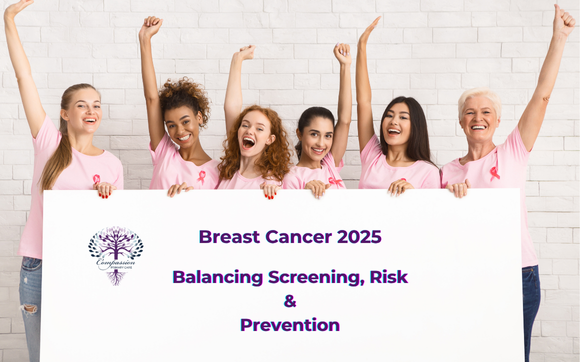Understanding the Scope
In 2025, about 316,950 U.S. women will receive an invasive breast cancer diagnosis.¹ While mortality has decreased over recent decades, the financial cost of care exceeds $30 billion annually, and the personal toll, from emotional distress to treatment side effects, remains high.²
The Mammogram Debate: What the Numbers Really Mean
Assumptions Behind Screening
Traditional mammography programs were built on two now-challenged ideas:
1. Breast cancers grow linearly and predictably, so earlier always equals better detection.
2. All detected cancers progress, justifying universal intervention. Yet research shows tumor behavior is heterogeneous; some grow rapidly, others never threaten life, and some regress spontaneously. ³
Radiation & False Positives
A single digital mammogram exposes a woman to ~0.4–0.5 mSv, roughly eight weeks of natural background radiation. ⁴ When performed annually for decades, cumulative dose matters, particularly in younger women.
False positives are also frequent: over 10 years of annual screening, 50–60 % of women experience at least one false alarm, leading to anxiety, extra imaging, and sometimes unnecessary biopsies. ⁵
Absolute vs Relative Risk Reduction
- Typical relative mortality reduction: 15–25 %. ⁶
- Absolute risk reduction (ARR): ~1–2 deaths prevented per 1,000 women screened over 10–15 years (≈ 0.1–0.2 %).⁷
- Number Needed to Screen: ~500–1,000 women for a decade to prevent one breast-cancer death.⁷
Thus, while mammography can save lives, the magnitude of benefit is modest, and must be weighed against overdiagnosis, radiation, and psychosocial harm.
Alternative & Adjunctive Screening Options
QT Scan (Quantitative Transmission Ultrasound)
QT scan uses three-dimensional ultrasound tomography to map breast tissue without compression or ionizing radiation. Early trials show:
- Comparable lesion detection to mammography in dense breasts⁸
- Improved patient comfort⁹
- No established mortality data yet
QT scan is FDA-cleared as an adjunct, not a replacement, and remains under evaluation in multi-center studies.
Auria Tears (Tear-Based Biomarkers)
The Auria test analyzes tear proteins associated with inflammatory or metabolic shifts linked to breast tissue changes.¹⁰ Preliminary data show promise but also high false-positive rates; large validation trials are ongoing. For now, tear-based tests are best viewed as non-invasive adjuncts, not substitutes for imaging.
Iodine and Breast Health: Revisiting the Evidence
Researchers like Dr. David Brownstein and Dr. Jeffrey Dach have long proposed that iodine plays a regulatory role in breast tissue, citing that mammary glands concentrate iodine and that deficiency may lead to dysplasia or atypia.¹¹ Animal studies show that iodine deficiency can trigger fibrocystic changes, while supplementation sometimes reverses them.¹²
- Epidemiologic observations link low iodine intake to higher breast cancer rates.¹³
- Human trials remain limited; small studies report symptom improvement in fibrocystic breast disease with molecular iodine supplementation.¹²
- Mainstream oncology views these findings as hypothesis-generating, pending randomized trials to define safety, dosage, and long-term outcomes.
- However, in clinical practice, both these doctors and many other clinicians utilize iodine treatment successfully in women with fibrocystic breast, breast cancer, and a plethora of other conditions.
In clinical practice, iodine optimization should consider thyroid function, halide exposure (bromide, fluoride, chloride), and be guided by a qualified practitioner.
Beyond Screening: Integrative Prevention Strategies
Hormone Optimization
Balanced estrogen-progesterone ratios reduce proliferative signaling in breast tissue. Supporting detoxification pathways (methylation, sulfation, glucuronidation) and minimizing environmental estrogens (BPA, phthalates, parabens) help maintain healthy hormone metabolism.¹⁴
Cortisol & Stress Regulation
Chronic cortisol elevation suppresses immunity, drives inflammation, and disrupts hormonal balance. Techniques such as mindfulness, breathwork, adaptogens, and exercise can restore HPA-axis resilience.¹⁵
Metabolic & Weight Management
Visceral fat promotes aromatase activity and inflammatory cytokines, raising postmenopausal breast-cancer risk. Exercise, strength training, and insulin-sensitizing diets lower risk.¹⁶
Nutrition & Lifestyle
- High intake of cruciferous vegetables, fiber, and omega-3 fats
- Adequate vitamin D, magnesium, selenium, zinc
- Time-restricted eating for improved insulin sensitivity
- Strict alcohol limitation, even low intake raises risk¹⁷
- Consistent 7–9 hours of restorative sleep to normalize melatonin and circadian rhythm¹⁸
Reframing the Conversation
Screening saves some lives, but not all, and carries costs, both human and financial. The future of breast cancer prevention lies in a personalized blend of appropriate imaging, metabolic optimization, stress resilience, and nutritional sufficiency, rather than reliance on one screening tool alone.
References
- American Cancer Society 2025 Estimates.
- National Cancer Institute, Cancer Care Costs 2020 Report.
- Bleyer A, Welch HG. N Engl J Med. 2012;367:1998–2005.
- U.S. FDA, Mammography Quality Standards Act.
- Nelson HD et al. JAMA Intern Med. 2016;176(12):1751-1760.
- Independent UK Panel on Breast Cancer Screening. Lancet. 2012;380:1778-1786.
- Gøtzsche PC, Jørgensen KJ. Cochrane Database Syst Rev. 2013;(6):CD001877.
- Duric N et al. Med Phys. 2014;41(2):023502.
- Skaane P et al. Radiology. 2020;296(2):284-291.
- Bhardwaj S et al. Front Physiol. 2022;13:861321.
- Brownstein D. Iodine: Why You Need It, Why You Can’t Live Without It. Medical Alternatives Press; 2023.
- Kessler JH. Breast J. 2004;10(5):404-406.
- Eskin BA et al. Breast Cancer Res. 2005;7(4):R506-R514.
- Kaaks R et al. Endocr Relat Cancer. 2022;29(2):R29-R50.
- Sephton SE et al. Psychoneuroendocrinology. 2016;69:1-10.
- Chlebowski RT et al. J Clin Oncol. 2020;38(20):2142-2152.
- Bagnardi V et al. Ann Oncol. 2015;26(8):1630-1638.
- Hansen J et al. Epidemiology. 2011;22(5):799-806.
Author: Dr. Stasha-Gae Roberts
Doctor of Nursing Practice
DNP, MPH, MSN, APRN, AGPCNP-BC
Nursing your journey to lasting wellness.
